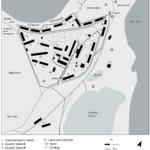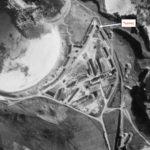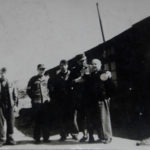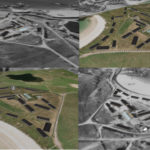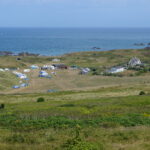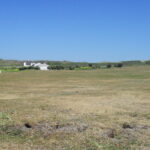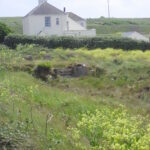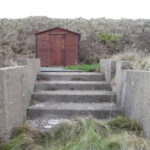Norderney
- Country: Alderney, The Channel Islands
- GPS: 49° 43' 42.7188 N, -2° 10' 40.3212 W,
- Address: Saye Farm
- Operational: N/A - Active
- Labourers Imprisoned at Norderney: Nathan Levy, Leonas Visocekas, Vital Gayman, Albert Levi, Albert Benjamin Mendelbaum, Francisco Font, Johannes Meijer, Norbert Beernaert, Jacobus Deijbel, Grzegorz Melnik, Florencio Cascarosa Pirla and Florencio Cascarosa Perez, José Vicente Anadón, Francisco Rubio Lopez, Théodore Haenel, Dr Ernest Morand (Friedman), Haim Parsimento, Gordon Augustin Prigent, Walter John Gallichan, Wilfred Henry Duport,
By Caroline Sturdy Colls and Kevin Colls
Although Sylt is regularly referred to as the only SS concentration camp on British soil, the SS took control of another of Alderney’s camps in 1943.1 Originally conceived as a housing complex for volunteer labourers and then as an Organisation Todt camp, by March 1942 Norderney was the largest of the four main camps on the island.2 The camp and the landscape that surrounded it facilitated the imprisonment of thousands of people, coming from around thirty countries, and it was here that the island’s largest contingent of Jewish prisoners was housed.3 The evolution of Norderney camp can be divided into three distinct phases where in each, the prisoner demographic and camp leadership varied considerably.
Phase 1: a camp for voluntary workers
When Norderney first opened in 1941, it was used to house voluntary workers. The first were French employees of the Munich-based firm Sager and Wörner, including a number of French women who were employed as cooks. In this early period, these workers were supposedly ‘not badly treated’.4 That said, there are many accounts indicating that French, Belgian and Portuguese women who came to the camp at various stages during the occupation were forced into sex work.5 Norbert Beernaert reported that ‘it was like a cattle market the morning after they arrived when the German officers looked them over. If they “stayed” with an officer, all they had to do was clean his room, make his bed and sleep in it. If they refused to do that, they ended up working in the camp kitchen, peeling potatoes.’6
Phase 2: an OT camp
Norderney became an OT labour camp in early 1942.7 A group of at least thirty-one Spanish prisoners arrived on 22 February and they were employed by the Deubau-Neumeyer firm undertaking construction works.8 These labourers were so-called Spanish Republicans who had fled the civil war and who had previously been working for the OT in Brest.9 Further transports arrived in the summer. Between June and August 1942, three transports of Eastern European workers arrived, totalling 2,800 men – mostly Ukrainians, but also Poles, Russians and men from Belarus, Georgia and the Crimea – of which more than a third were sent to Norderney.10 These workers were employed by a number of firms to do heavy construction works across the island, including Wolfer and Göbel, Fuchs and Sager and Wörner.11 A small number of German OT workers were also in the camp until the end of 1942, after which they were transferred to Borkum.12 After the arrival of Eastern European inmates in the summer of 1942, OT Truppführer Karl Dietz (sometimes spelt Tietz) took over for a period of three months until January 1943. Having previously been the commandant of Sylt labour camp, Dietz was described by British Investigator Pantcheff as the ‘most notorious beater of forced labourers on the island’ as he made a daily effort to assault prisoners for misdemeanours.13 Witnesses report how he beat inmates of Norderney mercilessly with the help of his Black-African assistant.14 On one occasion, this assistant reportedly ‘smashed a Russian’s skull with a blow of his ladle’ while serving soup in the labourers’ kitchen.15 By January 1943, the number of Norderney inmates reportedly stood at 900 and in February it increased again when prisoners housed in Sylt labour camp were transferred there due to the impending arrival of the SS.16
Phase 3: the SS arrive
According to prisoner Gordon Prigent, who was sent there as punishment for disobeying orders, Norderney did not officially become a concentration camp until 1944.17 However, many sources suggest that it effectively functioned with SS leadership for around a year before. In February 1943, SS Untersturmführer and OT Haupttruppführer Adam Adler was appointed to the role of Camp Commandant.18 Adler liked to wear his SS uniform around the camp and was known for his drunken behaviour and violent tendencies.19 During this phase of Norderney’s operations, its inmate demographic changed dramatically. In August, September and October 1943, more than 800 individuals were sent to the camp.20 This included French citizens and individuals from other countries who were arrested in France, including a group of North African prisoners (from Morocco, Tunisia and especially Algeria).21 Benoit Luc provides a comprehensive review of the French prisoners sent to Norderney in his book Les Déportes de France vers Aurigny: 1942–1944 and has demonstrated that the majority of Frenchmen sent to Norderney were Jews (at least 590 in total), most of whom arrived on 12 August and 11 October 1943.22 With these arrivals, Norderney became the main camp for Jewish inmates on the island and a ‘Jewish camp’ was created by fencing off eight barracks in the northern part of the camp’s terrain.23 The prisoner population was dynamic and around 1,500 people were housed in Norderney at any one time.24
Camp layout
Like many of the camps, the appearance and operational reality of Norderney was connected to the geography of both the region in which it was built and the island as a whole. Sand dunes, gullies, hills, roads, pre-war structures and existing infrastructure all provided opportunities or development, defence, camouflage and/or segregation. The site chosen for Norderney was a sheltered spot immediately south of Saye Bay, in the north-east corner of Alderney, where a farmhouse and outbuildings were used to house voluntary labourers (during Phase 1) before they were incorporated into the camp proper (during Phase 2).25 The well-built farmhouse was eventually used as the Camp Commandant’s living quarters and other outbuildings operated as a labourers’ kitchen and cookhouse. Many of the German additions to these structures, such as enclosing walls, are still visible in the landscape today. One former inmate referred to the camp as ‘Chateau’, possibly because Château L’Etoc was visible nearby.26
It developed throughout 1942, as more and more workers arrived, although the camp retained a consistent overall form from early 1942 onwards. By August 1942, it comprised twenty-six huts and, by October 1943, thirty-six structures were present, more than a third of which were living accommodation for forced and slave labourers. This made it by far the largest camp on Alderney. The borders of the camp utilised the natural topography and man-made features of the area. The sand dunes and a raised plateau on the north coast formed one part of the camp boundary, while the remainder comprised existing roads to the south and east. Initially, the camp did not have a substantial fence, that is, with barbed wire, guard towers and sentry positions, because the natural and man-made boundaries probably offered adequate deterrents to escape attempts. Inmates recalled how they were terrified of the sea to the point of considering suicide, particularly during bad weather.27
As time progressed, more substantive security measures were employed. Barbed wire and mined areas reportedly existed during the OT camp period (Phase 2).28 Kirill Nevrov, one of the Soviet labourers who arrived in late 1942, described how the fence was damaged in bad weather, allowing inmates to go down to the sea to wash lice from their bodies.29 By January 1943, the camp had a more substantial fence and gate. In the second phase of the camp’s operations, witnesses also report that North African inmates, Spaniards and French women were housed in separate barracks from the inmates from Eastern Europe.30
Mentioned above, witnesses also reported a separate compound within Norderney – known as Norderney II – which housed Jewish prisoners after the arrival of three large transports in the autumn of 1943. Nevrov recalled how ‘a few huts were separated from the rest by barbed wire. Special gates were made. It was a camp within a camp, designed specifically for the Jews.’31 The Jewish prisoners housed here had a yellow patch on their backs and a white stripe down each trouser leg to distinguish them from other inmates.32 The location of the Jewish camp barracks is likely to have been adjacent to the sand dunes on the northern side of the camp. Here eight barracks existed, consistent with the testimony of an anonymous Jewish inmate who was housed there.33
Daily life in the prisoner compound
Unlike some of the other camps, the barracks here were not dug deep into the ground. This was likely due to the belief that the northern sand dunes would afford them protection and because these buildings were some of the first camp structures to be built on Alderney. However, Nevrov reported that the waves breached the sand dunes and flooded one of the barracks that was ‘parallel to the sea-shore’.34 From July 1942 onwards, the barracks were overcrowded and unsanitary, and inmates had to contend with lice and disease.35 Some prisoners had three-tier bunk beds, others simply slept on pallets.36 Jewish prisoner David Trat described life in the Jewish section of the camp in late 1943: ‘we were put into a barracks where we slept on flea-infested mattresses. There were fleas and lice everywhere, in your hair even in your eyebrows. We tried to kill the insects when we could, before we went to bed, but we were exhausted.’37 Rats were also prevalent.38 A bathhouse existed in the main camp area and men some-times paid the guards in cigarettes to gain access so they could spy on the female workers.39 In 1943, water was reportedly brought in so that inmates in the Jewish zone could wash daily, suggesting that Jewish inmates did not have access to the bathhouse.40 Washing facilities instead took the form of a primitive ‘shower place’, without running water.
Norderney had separate kitchens in two different buildings: one where food for the guards was prepared and another where the labourers’ food was prepared and consumed. The labourers’ cook lived in a separate building adjacent to the labourers’ kitchen. Rations in Norderney for the unprivileged labourers were poor. Gordon Prigent reported that inmates had to queue up for a morning roll call, at which they would receive a ladle of coffee. Lunch and dinner both consisted of ‘a ladle of hot water, cabbage leaf and one slice of bread’, even though inmates were often forced to work for sixteen hours a day.41
Throughout the occupation of Alderney, Norderney was a landscape of violence as inmates were regularly beaten and many died within its grounds. Beernaert reported that as many as ‘ten people were dying in Norderney daily’ at the beginning of 1943 as a result of the ill-treatment, which consisted of beatings, poor medical treatment, starvation and disease.42 Emil Sulikowski was not alone when he described seeing prisoners being beaten so badly that their bodies were carried away; pickaxe handles and other blunt instruments, used for beatings, were reportedly the weapons of choice for some of the guards.43 Other prisoners report seeing skeletal corpses being taken away for burial, showing clear signs of malnourishment. Executions were also described by some witnesses. For example, Wilfred Henry Dupont saw two Frenchmen being shot outside their barracks in Norderney because they did not take shelter from bombings that were occurring in June 1944.44 The Commandant’s house also seemingly became a site of violence. Misiewicz recalled cleaning up blood from the floor, from inmates that had been beaten.45
Medical treatment in the OT camps was especially poor. If inmates were deemed to be ‘stretcher cases’, or they were permitted to receive medical treatment for other reasons, they might be sent to the hospital barrack in Norderney.46 This applied to prisoners who fell ill in the other camps or who sustained injuries at work. Witnesses report that this barrack contained twenty to thirty beds and that it was reserved for serious cases of illness; thus, it was by no means guaranteed that treatment would be received.47 In fact, many inmates were refused medical treatment by the camp guards who made an assessment on whether they thought an individual was ill enough to receive assistance.48
One very important architectural element of Norderney’s landscape survives in the form of the socalled ‘tunnel of death’, located in the north-east corner of the camp. This stone-built tunnel was already in existence when the camp was built, and it provided access from Saye Bay to the beach in Corblets Bay; hence it existed both within and outside the camp boundaries. Inmates of Norderney were forced to repair it, the purpose of which was to ensure that it could be used as a place to kill inmates should the Allies invade or bomb the island.49 According to witnesses and official documents, the upper echelons of the Nazi administration feared the Allies would discover how the Germans had treated forced labourers in Alderney should any be left behind to testify in the event of an invasion. A Jewish inmate referred to as E.F. suggested that the use of the ‘tunnel of death’ to eradicate inmates was an initiative of the SS and that they intended to kill all prisoners under SS control there.50 Prigent describes how ‘if there had been a landing, we were told at roll call there would be an alarm and we would have to get into this tunnel, and if you weren’t into this tunnel by two minutes you were shot on site’.51 Several practice runs took place to prepare prisoners for such an action.
Thankfully, the tunnel was never knowingly used for the purpose of carrying out executions, since Norderney was evacuated and gradually closed after the spring of 1944. Aerial photographs reveal that the Germans began to demolish some of the huts north of the farmhouse in March 1944 and then several of the buildings in the main compound were torn down by May.52 Some of Norderney’s camp structures remained when the British military investigators arrived on Alderney in May 1945 following the liberation of the island. These included the pre-war buildings but also some of the prisoner huts. Unlike Sylt concentration camp, Norderney was not recorded spatially, most likely in the belief that it was just another labour camp ran by OT.
In conclusion, of all the camps built in Alderney, Norderney housed the most diverse inmate population and had the largest capacity. Because it was officially an OT labour camp, the role it played in the Germans’ maiming and, in many cases, the killing of forced, slave and less-than-slave labourers has often been overlooked. Throughout its entire period of operation, the labourers housed here consistently suffered brutal treatment. This occurred at the hands of the OT guards, whose lack of experience and discipline meant that they were unable to maintain the balance between controlling the inmates and inflicting serious bodily harm, and later their SS overseers, who sought to implement tighter measures consistent with those employed in other Nazi concentration camps. Norderney was also the main camp for Jewish prisoners on Alderney and these inmates, as well as Eastern European workers, were treated particularly harshly. Beatings and other forms of interpersonal violence were a daily occurrence, while the threat of mass killings lingered over inmates because of the ‘tunnel of death’ situated at its periphery. The landscape of Norderney was utilised by the guards, perhaps more so than at any other camp, in order to control the camp inmates and limit the chances of escape, while its architecture facilitated segregation and led to poor hygiene. Although Norderney was the location of an OT labourer hospital (where inmates from other camps were also sent), most labourers who spent time at the camp experienced illness, cruelty and even death. The site’s current appearance and use does little to recognise the suffering that occurred in this landscape or to acknowledge Norderney’s significance in the persecution of forced, slave and less-than-slave labourers on Alderney.
References:
1 TNA, WO311/13, ‘Report No. PWIS(H)/KP/704 on Alderney Atrocities No. 2’, 18 July 1945.
2 TNA, WO311/11, ‘Letter from Major Haddock to Brigadier Shapcott’, 21 May 1945; TNA, WO311/11, ‘Report from Sjt Francis Bennett to 10-I(B) HQ Force 135’, 23 May 1945; C. Sturdy Colls and K. Colls, ‘Reconstructing a Painful Past: A Non-Invasive Approach to Reconstructing Lager Norderney in Alderney, the Channel Islands’, in E. Ch’ng, V. Gaffney and H. Chapman (eds), Visual Heritage in the Digital Age (New York: Springer, 2014), pp. 119-146.
3 C. Sturdy Colls and K.S. Colls. ‘Adolf Island’: The Archaeology of the Occupation of Alderney (Manchester: Manchester University Press, 2022).
4 TNA, WO311/12, ‘Statement of Rudolf Gronerâ’, 30 May 1945.
5 G. Nebel. Bei den nordlichen Hesperiden (Wuppertal: Wuppertal im Marées-Verlag oJ, 1948); Ted Misiewicz, in Bunting, M. 1996 The Model Occupation: The Channel Islands Under German Rule 1940-45. Harper Collins pp. 175- 179, and Norbert Beermart in Bunting, The Model Occupation, pp. 179-181.
6 Norbert Beermart in Bunting, The Model Occupation, p.181.
7 Bonnard, B. 1993, Alderney at War. Stroud: The History Press.
8 Luc, Les déportés de France vers Aurigny, p. 15; TNA, WO311/13, ‘Translation of statement by PW KP 256520 Grenadier Walter Schüller’, 10 July 1945.
9 Luc, Les déportés de France vers Aurigny, p. 133.
10 Pantcheff, Alderney Fortress Island, p. 8; WO311/13, ‘German occupation of Channel Islands: death and ill treatment of slave labour and transportation of civilians to Germany’. 10 July 1945.
11 TNA, WO311/13, ‘Translation of Statement by PW KP 256520 Grenadier Walter Schüller’, 10 July 1945; IA, FK31- 11, ‘OT Death Certificates, Misc. dates.
12 Ibid
13 Pantcheff, Alderney Fortress Island, pp. 7 and 13
14 Fjodor Nozdrin in B. Bonnard, 1991. The Island of Dread in the Channel: Story Georgi Ivanovitch Kondakov. Stroud: Amberley Publishing Limited, 1991, pp. 97–98.
15 Ibid
16 Pantcheff, T.X.H. 2005 Alderney Fortress Island. Phillimore and Co, p. 8; TNA, WO311/13, ‘Report No. PWIS(H)/KP/702. Report on Atrocities in Alderney (1942–1945)’, 23 June 1945.
17 Ivan Dolgov and Kirill Nevrov, in Bonnard, The Island of Dread, p. 35; Jersey Heritage Trust, ‘Mr Prigent’, www.jerseyheritagetrust.org/edu/ resources/pdf/prigent.pdf (accessed 14 April 2009); F. Cohen, The Jews in the Channel Islands during the German Occupation 1940-45 (Jersey and London: Jersey Museums Service, 2000), pp. 143- 146.
18 TNA, WO311/13, ‘Report No. PWIS(H)/KP/704 on Alderney Atrocities No. 2’, 18 July 1945 states that Adler took up his post in February 1943. Other sources have suggested that he arrived later in August 1943. See Luc, Les déportés de France vers Aurigny, p. 73.
19 TNA, WO311/13, ‘Report No. PWIS(H)/KP/704 on Alderney Atrocities No. 2’, 18 July 1945; Adler appears to have also sometimes worn an OT uniform. 34 Wingeate Pike, Spaniards in the Holocaust, p. 7. From March 1944, Adler had o report to SS-Obersturmführer Georg Braun, the Commandant of Sylt con-centration camp. It is unclear whether he had to report to his predecessor List prior to this.
20 Luc, Les déportés de France vers Aurigny; S. Klarsfeld, Le Calendrier de la persecution des Juifs de France 1940- 1944 (Paris: The Beate Klarsfeld Foundation, 1993).
21 Luc, Les déportés de France vers Aurigny pp. 16 and 247.
22 id., pp. 44–53 and Annex 7.
23 WO311/34, ‘Letter from Pantcheff to SIO PWIS (Norway)’, 13 August 1945 YV 3687663, O.51/ file 226, ‘The War of 1939-1945. Historical Facts on Alderney (Channel Islands) – written by Colin Partridge with assistance from members of Amicale Anciens Déportés de I’lle anglo-normande d’Aurigny (Alderney)’ Paris, undated.
24 Two German documents from November 1943 refer to the number of people in the camp but the text is difficult to read. It likely states either 1,500 or 1,600 inmates were housed in the camp. See ITS, 2.2.3.0/82360574, ‘Lagerstärkmeldung’, 1 November 1943; ITS, 2.2.3.0/82360572, ‘Lagerstärk-meldung’, 15 November 1943.
25 Sturdy Colls and Colls, ‘Reconstructing a Painful Past’, p. 131.
26 ITS, 2.2.3.0/82361077, ‘Bogdanow, Vitali’, 15 February 1944.
27 Kirill Nevrov, in Bunting, The Model Occupation, pp. 164–167; Bonnard, The Island of Dread, p 86.
28 Jersey Heritage Trust, ‘Mr Prigent’, www.jerseyheritagetrust.org/edu/resources/pdf/prigent.pdf (accessed 14 April 2009).
29 Bonnard, The Island of Dread, p. 99
30 Jersey Heritage Trust, ‘Testimony of Reuven Freidman’, www.jerseyheritagetrust.org/edu/resources/pdf/freidman.pdf (accessed 5 December 2008); ‘Plan by Ted Misiewicz’, in Bunting, The Model Occupation, p. 159.
31 Bonnard, The Island of Dread, p. 111.
32 AG-NG, 1515, ‘E.F. Anonymised Interview’, undated.
33 GMA, R136/2, ‘Interview with E.F’, 26 November 1991; AG-NG, 1515, ‘E.F. Anonymised Interview’ undated.
34 Kirill Nevrov, in Bonnard, The Island of Dread, pp 86; G. Kondakov (ed. T. Chernakova), ‘Alderney Island (Great Britain) and France’, in N. Komolova (ed.). Soviet People in the European resistance (Memoirs and documents). Part II (Moscow: Institute of World History at Soviet Academy of Science, 1991) p. 293 (Original language title: Кондаков Г.И. Остров Олдерни (Великобритания) и Франция/Публ.Т. А.Чернаковой // Комолова Н.П. (Отв. ред.). Советские люди в Европейском сопротивлении. (Воспоминания и документы). Часть II. М., 1991. —С. 293).
35 David Trat, in Cohen, F. 2000 The Jews in the Channel Islands. Jersey Museum Service, p. 134.
36 Jersey Heritage Trust, ‘Mr Prigent’, www.jerseyheritagetrust.org/edu/resources/pdf/prigent.pdf (accessed 14 April 2009); Jersey Heritage Trust, ‘Testimony of Reuven Freidman’, www.jerseyheritagetrust.org/edu/resources/pdf/freidman. pdf (accessed 5 December 2008).
37 David Trat, in Cohen, The Jews in the Channel Islands, p. 134; Klarsfeld, Le Calendrier de la persecution des Juifs de France, p. 846.
38 Theodore Haénel, in Luc, B. 2005 Les déportés de France vers Aurigny. Editions Eurocibles, pp. p. 161.
39 Ted Misiewicz, in Bunting, The Model Occupation, pp. 175–179; Norbert Beermart in Bunting, The Model Occupation, pp. 179–181.
40 Jersey Heritage Trust, ‘Testimony of Reuven Freidman’, www.jerseyheritagetrust.org/edu/resources/pdf/freidman.pdf (accessed 5 December 2008).
41 Jersey Heritage Trust, ‘Mr Prigent’, www.jerseyheritagetrust.org/edu/resources/pdf/prigent.pdf (accessed 14 April 2009).
42 Bunting, The Model Occupation, p. 182.
43 GARF, Fond 7021, Opis 149, Delo 167, ‘Testimonies made by Emil Shulikovsky’, 10 June 1945; See also: TNA, WO311/12, ‘Statement of Peter Lempkin’, 19 May 1945; TNA, WO311/13, ‘Report No. PWIS(H)/KP/702. Report on Atrocities in Alderney (1942-1945)’, 23 June 1945.
44 TNA, WO311/11, ‘Statement of Wilfred Henry Dupont’, 1945.
45 Ted Misiewicz, in Bunting, The Model Occupation, pp. 175–179. 46 TNA, WO311/12, ‘Statement of Frank Alfred Bullock’, 1945.
47 TNA, WO311/13, ‘Report No. PWIS(H)/KP/704 on Alderney Atrocities No. 2’, 18 July 1945. 48 IWM, MISC 2826, 189/2, Nr. 3376, ‘Interview with Ted Misiewicz’, undated.
49 JA, L/C/24/B/1, ‘TMP de Paris. Caserne de Reuilly. Acte d’accusation dans l’affaire Heinrich Evers et Adam Adler, inculpés de coups et blessures volontaires et de vol’, 20 September 1949; TNA, WO311/12, ‘Besondere Anordnungen Nr. 4’, 10 May 1944.
50 GMA, R136/2, ‘Interview with E.F’, 26 November 1991; AG-NG, 1515, ‘E.F. Anonymised Interview’, undated.
51 IWM, MISC 2826 189/2, Nr. 4390 and 4391, ‘Interview with Gordon Prigent’, undated.
52 NCAP, ACIU MF C1978, 20 March 1944; NCAP, ACIU MF C2208, 10 May 1944.
Map
- Cemetery / Mass Grave
- Concentration Camp
- Forced Labour Camp
- Prison
- Worksite / Fortification

